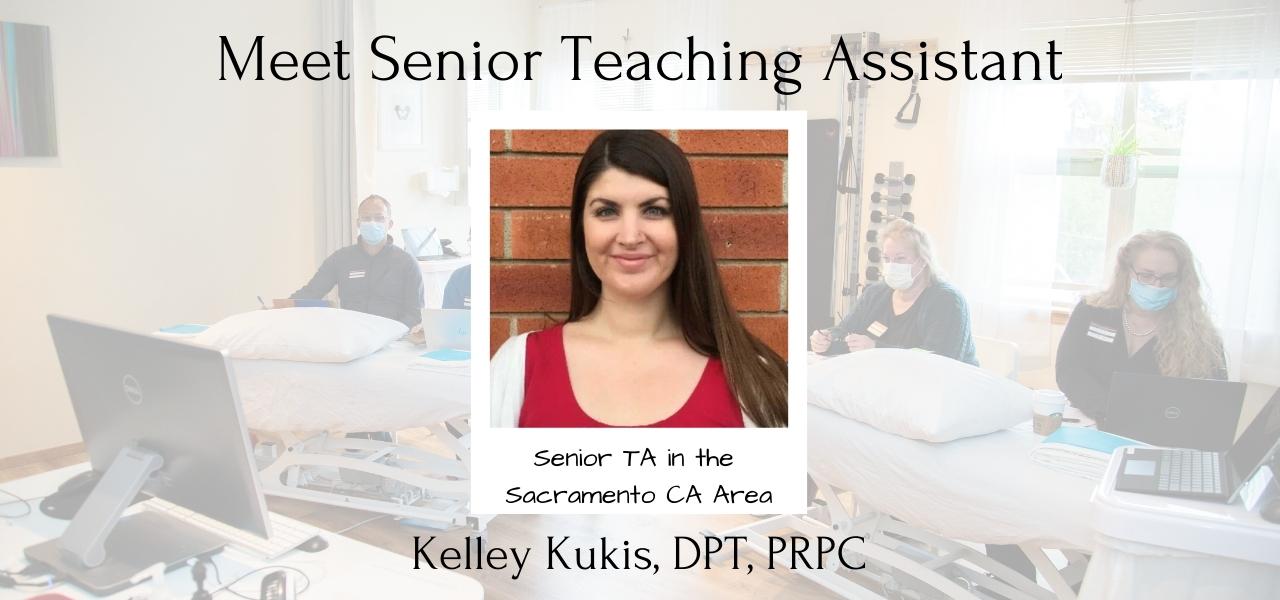Meet Senior Teaching Assistant: Kelley Kukis, DPT, PRPC

Kelley Kukis, DPT, PRPC sat down with The Pelvic Rehab Report this week to discuss herself and how she came to TA for Herman & Wallace.
Who are you? Describe your clinical practice.
I’m Kelley Kukis, DPT, PRPC, and I’m a pelvic PT at East Sacramento Physical Therapy, or East Sac PT as we are referred to locally. East Sac PT has been a pelvic health clinic for over 30 years, and early on the owners, Risa and Jim MacDonald had to educate other medical providers about what pelvic PT was and how it would help their patients. Now the clinic treats adult and pediatric patients of all genders with pelvic dysfunction as well as adult patients with orthopedic conditions.
I also organize the Sacramento Pelvic and Sexual Health Professionals Network (Sac PuSHPiN), which is a network of PTs, MDs, mental health therapists, sex educators, and more, who meet quarterly and share ideas about pelvic and sexual health.
In addition to being a lead TA for Herman & Wallace, I do some guest teaching at my alma mater, California State University, Sacramento (CSUS).
What has your educational journey as a pelvic rehab therapist looked like? Where did you start?
Some of my earliest jobs were movement related. I taught swim lessons, yoga classes, and dance classes in high school and college. I earned a teaching credential and had a career as an elementary teacher for a few years. Unfortunately, I entered teaching in the midst of a difficult economy. As a newer teacher, I was laid off every year due to uncertain education budgets and had to reapply each fall, which became very stressful after 5 years.
I decided to go back to school to be a school PT because as a teacher, I was familiar with rehab in a school setting, but I was pretty naive about what getting into and completing PT school meant. Because I didn’t have a kinesiology degree, I had to take a few years of prerequisite classes while I worked as a dance instructor and professional dancer. I got into the PT program at CSUS and was exposed to the wide variety of settings available for PTs to practice in. When I did a clinical rotation at East Sac PT, I fell in love with pelvic health and never looked back. I took Pelvic Floor 1 as a student in preparation for my clinical rotation, and I completed the rest of the pelvic series after graduation. I earned my PRPC the following year.
How did you get involved in the pelvic rehabilitation field?
One thing that drew me to pelvic rehabilitation was the amount of time we get to spend really getting to know patients. Patients will often tell us things they haven’t told other medical providers, and I love helping patients solve mysteries about their bodies and make new connections. I also love that the little things we do can make a big difference. I gave a constipated patient an abdominal massage, and she returned and called me a “poop doula”.
What patient population do you find most rewarding in treating and why?
I love treating dyspareunia because it’s often something that people have lived with for a long time and thought was either normal or untreatable. I also love working with the LGBTQIA+ community because as a queer person I know that finding queer-competent healthcare providers is more difficult than it should be.
If you could get a message out to physical therapists about pelvic rehab what would it be?
Ask every patient specific questions about their pelvic health. Often patients won’t tell you that they are having incontinence or pelvic pain unless you ask them specifically. These are things that should be screened for at every PT evaluation. PTs also need to get really comfortable asking these questions because if you as the PT are nervous or embarrassed, your patient won’t be honest with you.
What lesson have you learned in a course, from an instructor, or from a colleague or mentor that has stayed with you?
I’ve learned so much from my mentor Risa MacDonald, but one of the most useful things I observed from her is the phrase “you’re right”. She starts nearly every bit of patient education with it, and it’s magic. If you start out telling a patient something they’re right about, they’ll listen to almost anything you have to say after that.
What do you find is the most useful resource for your practice?
I love podcasts. I listen to them while I’m getting ready for work or while I’m working around the house on the weekends. There are so many, but some of the podcasts in my rotation right now are At Your Cervix, Decolonizing Fitness, Foreplay Radio, Pain Science and Sensibility, The Nutrition Diva, The Penis Project, and Tough to Treat. One of my all-time favorite podcasts is Ologies, which is not a pelvic health-specific podcast but which does have some pelvic health-themed episodes, such as “Phallology”, which is what got me hooked.
What is in store for you in the future as a clinician?
I am loving the journey of continuing to learn about different aspects of pelvic health. I’d love to work more in PT education, and I have plans to own a clinic at some point in the future.
What books or articles have impacted you as a clinician?
I’ve just registered for Diane Lee’s ISM series, so I’m working my way back through The Pelvic Girdle and The Thorax right now. Both are such a dense wealth of information that give me new perspectives each time I go through them. I aspire to understand anatomy at as deep a level as Diane Lee.
What has been your favorite Herman & Wallace Course and why?
Megan Pribyl’s Nutrition Perspectives course dramatically changed both the way I eat and the way I talk to patients about nutrition. I recommend it to people every time I TA. I also learned so much in Lila Abbate’s Pudendal Neuralgia course.
What lesson have you learned from a Herman & Wallace instructor that has stayed with you?
I started fermenting things and sprouting grains after taking Megan Pribyl’s course. I’ve also fashioned several pelvic models out of pipe cleaners after taking Jen Vande Vegte’s courses.
What do you love about assisting at courses?
I love meeting other PTs and learning things from them. Our field has so many passionate and talented PTs with so many interesting ideas. It’s also really fun to see how other clinics are set up and run. And even when I’ve TA’ed a course several times, it’s always valuable to hear the material with a new instructor and practice it with a different set of PTs. I learn so many new things each time.
What is your message to course participants who are just starting their journey?
Assume nothing! Even with the most open mind, patients will make you realize the assumptions and biases you’re bringing into the treatment room. Just when you get comfortable, a patient will throw you an absolute curve ball. This is what makes our specialty interesting though!
By accepting you will be accessing a service provided by a third-party external to https://hermanwallace.com/







































